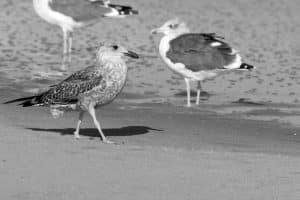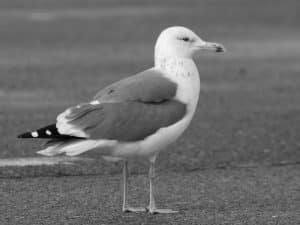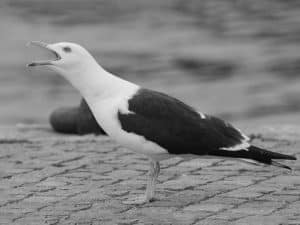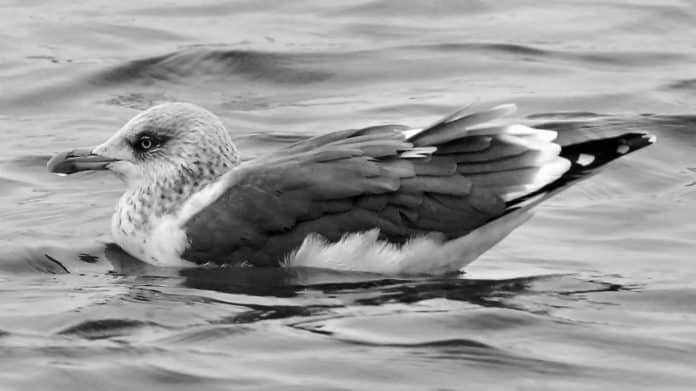Introduction to the Lesser Black-Backed Gull
The Lesser Black-Backed Gull, scientifically known as Larus fuscus, is a migratory seabird that has gained popularity among birdwatchers in Tanzania. This species is native to the northern regions of Europe and Asia, but it also visits the East African shores during its annual migration. The Lesser Black-Backed Gull in Tanzania is easily identifiable by its black back and wings, yellow bill, and striking white head and underparts. These gulls are medium-sized, with an average length of 55 centimeters and a wingspan of around 130 centimeters.
Distribution and Migration Patterns of the Lesser Black-Backed Gull

The Lesser Black-Backed Gull has a vast distribution range, breeding in the coastal areas of northern Europe, including the United Kingdom, Scandinavia, and the Baltic states. During the non-breeding season, these gulls migrate southwards, reaching as far as East Africa. Tanzania is one of the favored destinations for these migratory birds due to its favorable climate and rich feeding grounds along the coast and inland water bodies.
Lesser Black-Backed Gull Sightings in Tanzania
Tanzania provides excellent opportunities for birdwatchers to observe the Lesser Black-Backed Gull in its natural habitat. The gulls can be spotted along the coastline, especially around Dar es Salaam, Zanzibar, and Pemba Island. They are also commonly seen near large freshwater bodies such as Lake Victoria, Lake Tanganyika, and Lake Nyasa. The Lesser Black-Backed Gull is known to gather in large flocks, making their presence even more mesmerizing for bird enthusiasts.
Habitat and Behavior of the Lesser Black-Backed Gull
The Lesser Black-Backed Gull is highly adaptable and can be found in a variety of habitats, ranging from coastal areas to inland lakes and reservoirs. They prefer nesting on rocky cliffs, sand dunes, or flat ground near water bodies. These gulls are opportunistic feeders and have a diverse diet, including fish, crustaceans, insects, and even scavenged food. During the breeding season, they establish territories and engage in courtship displays, which involve aerial acrobatics and loud calls.
Conservation Status of the Lesser Black-Backed Gull in Tanzania

In Tanzania, the Lesser Black-Backed Gull is classified as a species of least concern, according to the International Union for Conservation of Nature (IUCN). However, it is essential to monitor their populations and protect their habitats to ensure their long-term survival. The coastal areas where they breed and the inland water bodies they frequent are vulnerable to habitat degradation and pollution. Conservation efforts should focus on raising awareness among the local communities and implementing measures to mitigate these threats.
Threats and Challenges Faced by Lesser Black-Backed Gulls in Tanzania
Despite their current conservation status, the Lesser Black-Backed Gulls in Tanzania face several threats and challenges. One of the significant threats is the loss of suitable breeding habitats due to human activities such as coastal development and sand mining. Pollution from oil spills and industrial waste also poses a risk to their survival. Climate change and its impact on sea levels and weather patterns may disrupt their migration routes and affect their availability of food. Additionally, disturbance from human activities, such as boating and recreational beach activities, can disrupt their breeding and feeding behaviors.
Lesser Black-Backed Gull Research and Monitoring Efforts in Tanzania
To better understand the population dynamics and behavior of the Lesser Black-Backed Gulls in Tanzania, ongoing research and monitoring efforts are crucial. These efforts involve conducting regular surveys and collecting data on their distribution, abundance, and breeding success. By studying their movements and migratory patterns, researchers can identify critical stopover sites and implement targeted conservation measures. Collaborations between local and international organizations play a vital role in supporting these research and monitoring initiatives.
Lesser Black-Backed Gull Photography Opportunities in Tanzania

Tanzania offers excellent opportunities for photographers to capture stunning images of the Lesser Black-Backed Gulls. The coastal areas provide picturesque backdrops, with the gulls soaring against the clear blue sky or perched on rocky cliffs. The reflective waters of the inland lakes and reservoirs create beautiful reflections and allow for unique compositions. Photographers can experiment with different angles and lighting conditions to capture the elegance and beauty of these migratory birds.
Lesser Black-Backed Gull Watching Tips in Tanzania
For birdwatchers planning to observe the Lesser Black-Backed Gulls in Tanzania, here are some helpful tips. Firstly, it is advisable to visit during the non-breeding season, between November and April, when these gulls are more abundant. Coastal areas such as Dar es Salaam and Zanzibar are good starting points, but exploring other regions with large freshwater bodies can also yield rewarding sightings. Carrying a pair of binoculars and a field guide specific to African birds is essential for accurate identification and a more immersive birdwatching experience.
Lesser Black-Backed Gull Conservation Initiatives in Tanzania
Tanzania has implemented various conservation initiatives to protect the habitats of the Lesser Black-Backed Gulls and ensure their long-term survival. National parks and protected areas along the coast and inland have been established to safeguard their breeding and feeding grounds. These areas are managed with strict regulations to minimize human disturbance and maintain the ecological balance. Additionally, educational programs and awareness campaigns are conducted to engage local communities and promote the importance of conserving these migratory birds.
Lesser Black-Backed Gull Sightings by Birdwatchers in Tanzania
Birdwatchers from around the world have shared their sightings and experiences of observing the Lesser Black-Backed Gulls in Tanzania. Many have marveled at the sheer numbers and elegance of these gulls, especially during their migratory stopovers. Their graceful flight and synchronized movements in large flocks create a mesmerizing spectacle. Birdwatchers have also appreciated the diverse habitats that Tanzania offers, enabling them to observe these gulls in different settings, from pristine beaches to vast lakes.
Lesser Black-Backed Gull Conservation Success Stories in Tanzania
Conservation efforts in Tanzania have yielded some notable success stories concerning the Lesser Black-Backed Gull. Through collaboration between government agencies, NGOs, and local communities, several breeding colonies have been protected and restored. The establishment of marine protected areas and the enforcement of regulations have significantly reduced disturbance and pollution in their habitats. The increased awareness and involvement of the local communities in conservation activities have also been instrumental in securing the future of these migratory birds.
Conclusion: Appreciating the Presence of the Lesser Black-Backed Gull in Tanzania
The Lesser Black-Backed Gull’s annual visit to the East African shores of Tanzania is a remarkable natural phenomenon that deserves appreciation and conservation. These migratory birds bring life and beauty to the coastal areas and inland lakes, captivating birdwatchers and photographers alike. By understanding their habitat requirements, behavior, and the threats they face, we can work towards ensuring their continued presence in Tanzania. Conservation efforts, research, and monitoring initiatives, along with active community participation, are essential in protecting the Lesser Black-Backed Gull and its habitats for future generations to admire and enjoy.

































